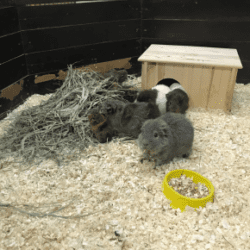Get Estcourt Vets’ tips for keeping small furries safe from flystrike
Flystrike, also known as myiasis, is a severe and potentially fatal condition that can affect rabbits and guinea pigs. It occurs when flies lay their eggs on the animal’s fur, which then hatch into maggots and burrow into the animal’s flesh. In this article, Estcourt Vets’ Head Vet Scott discusses how to prevent your rabbit or guinea pig from getting flystrike.
Call us on 01380 723687 if you spot signs of flystrike in your small furry pets.
5 Ways to Avoid Flystrike
1. Keep your pet’s living area clean
Flystrike most commonly occurs in dirty or unhygienic living conditions. To prevent flystrike, it’s essential to keep your pet’s living area clean and well-maintained. Scott recommends regularly cleaning the cage or hutch, removing any soiled bedding, and keeping the area free of faeces and urine. This is the best way to keep your pet’s risk of flystrike down.
2. Check your pet’s bottom
Rabbits and guinea pigs are most susceptible to flystrike in their rear ends, where it is difficult for them to clean themselves properly. To prevent flystrike, it’s essential to check your pet’s bottom daily, especially during the summer months. If you notice any signs of soiling or moisture, clean the area immediately and monitor it closely for any signs of flystrike. Contact us if you’re concerned and our team of nurses will be happy to advise.
3. Use fly screens or netting
Flies are attracted to moist and dirty areas, making your pet’s living area an ideal breeding ground. To prevent flies from entering your pet’s living area, consider using fly screens or netting on windows and doors. This will prevent flies from entering the living area and reduce the risk of flystrike.
4. Use insect repellents
Insect repellents can be an effective way to prevent flies from landing on your pet and reducing the risk of flystrike. However, it’s essential to use a repellent that is safe for your pet and not toxic if ingested. Speak with one of our vets or nurses about the best insect repellent options for your pet.
5. Consider hair trimming
Long or matted fur can provide an ideal breeding ground for flies, making your pet more susceptible to flystrike. Consider trimming your pet’s hair, particularly around the rear end, to reduce the risk of flystrike. However, be careful not to trim too close to the skin, which can cause skin irritation and make your pet more vulnerable to flies. This is something Estcourt Vets’ experienced team of nurses could help you with. Contact now to chat to our nursing team.
In conclusion, flystrike is a severe and potentially fatal condition that can affect rabbits and guinea pigs from all over Wiltshire. By keeping your pet’s living area clean, checking their bottom daily, using fly screens or netting, using insect repellents, and considering hair trimming, you can significantly reduce the risk of flystrike and keep your pet healthy and happy. If you notice any signs of flystrike, Scott advises to seek veterinary attention immediately.
< Back to articles Estcourt Vets Devizes
Estcourt Vets Devizes